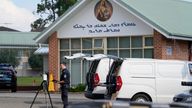Carbon monoxide 'likely' to have affected New Year's Eve crash pilot
The 2017 tragedy claimed the lives of leading British businessman Richard Cousins, his two sons, his fiancee and her daughter.
Friday 3 July 2020 12:31, UK
A pilot whose seaplane crashed in 2017 killing five Britons is likely to have had his ability to fly impaired by carbon monoxide, according to investigators.
British businessman Richard Cousins, the chief executive of the world's largest contract catering company Compass, was killed along with his two sons, Edward, 23, and William, 25, his fiancee Emma Bowden and her 11-year-old daughter Heather, during a New Year's Eve sightseeing trip near Sydney which ended in tragedy.
The de Havilland Canada DHC-2 Beaver, piloted by Canadian Gareth Morgan, who also died, plunged into the Hawkesbury River off Jerusalem Bay, 25 miles north of Sydney, after picking the family group up from an exclusive restaurant.
Releasing an update on the investigation, the Australian Transport Safety Bureau (ATSB) said blood tests indicated the pilot and two of the passengers had elevated levels of carbon monoxide.
The bureau's chief commissioner Greg Hood said: "From ... consultation with medical experts, and research into the effects of carbon monoxide on aircraft operations, the ATSB considers the levels of carbon monoxide were likely to have adversely affected the pilot's ability to control the aircraft."
A preliminary report from 2018 said the plane came down away from the expected and standard flight path, crashing in a near-vertical position.
At the time, Aaron Shaw, chief executive of operator Sydney Seaplanes, said the aircraft "simply should not have been where it was" and that the manoeuvres prior to the crash were "inexplicable".
As part of the ATSB investigation, the aircraft has been examined and there have been attempts to replicate the potential source of carbon monoxide and its entry into the aircraft cabin.
They found pre-existing cracking of part of the engine exhaust, which could lead to leakage into the engine bay.
Mr Hood added: "This investigation is ongoing, and our final report, which will contain specific findings, is anticipated to be released in coming months, so we are limited in discussing specific details.
"However, if at any time during an investigation, should the ATSB identify issues that are critical to safety, we will immediately notify relevant stakeholders so proactive safety action can be taken to help prevent similar occurrences."




